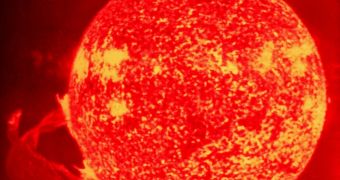The Sun's outer layer is in a constant turbulent state, creating waves all across the solar surface, making its experience a patchwork pattern of peaks and troughs. The Solar and Heliospheric Observatory has recently determined that these waves may be created in the outcome of solar flares exploding on the surface, fact which could provide an opportunity to study some of the most mysterious phenomenons occurring on the Sun, and possibly on other stars as well.
These waves are often referred to as the 5-minute oscillations and have a frequency of roughly 3 millihertz. According to researchers, the oscillation was previously regarded rather similar to that created by random sand grains hitting a bell left in the middle of a desert. Albeit, scientists from the University of Aarhus say that in fact the data was not interpreted correctly.
"The signal we saw was like someone was occasionally walking up to the bell and striking it, which told us that there was something missing from our understanding of how the Sun works," says Christoffer Karoff from the University of Aarhus.
Further investigation has revealed that the strength of the oscillations is increasing with the number of solar flares occurring at one given time. "The strength of the correlation was so strong that there can be no doubt about it," Karoff continues. Earth experiences a very similar phenomenon in the outcome of powerful earthquakes, which can determine seismic vibrations lasting as much as a few weeks.
"We are not completely sure how the solar flares excite the global oscillations," however by establishing a mechanism through which solar flares influence these oscillations, researchers may obtain a correlation that would give them the ability to monitor solar flares on other stars. In several observations, Karoff proved that solar flares could create similar oscillations on other stars as well.
"Now we need to monitor these stars for hundreds of days," but this would require a space observatory, says Karoff. Nonetheless, the study is just beginning.

 14 DAY TRIAL //
14 DAY TRIAL //